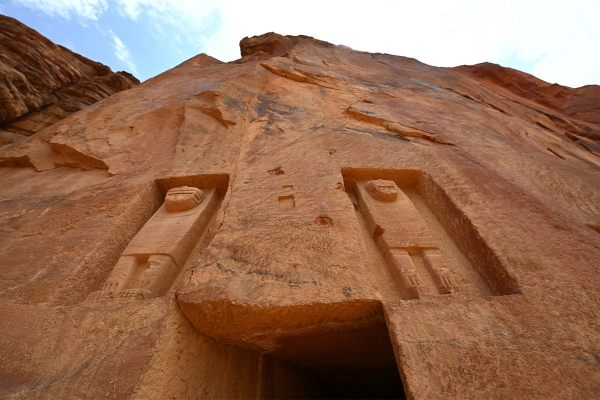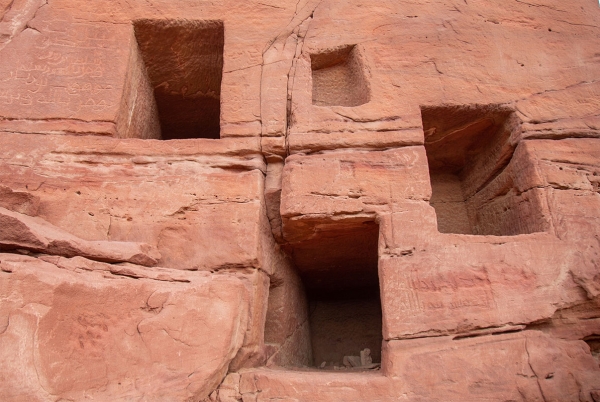


The Lion Tombs Inscription in al-Ula Governorate is a collection of inscriptions that are believed to have been written in the ninth or tenth century. They are among the inscriptions found in al-Ula Governorate and carry significant historical value. These inscriptions are part of the Islamic inscriptions along the Levant Hajj Route in the northwest of the Kingdom of Saudi Arabia. They include statements affirming the testimony of monotheism (Shahada), declarations of seeking forgiveness (Istighfar), affirmations and encouragements to rely on Allah (Tawakkul), and testimonies affirming that Allah is truth.
The inscription was made in the Lion Tombs in al-Ula Governorate, on a rock facade, with a shallow carving, over an area of ninety-seven by fifty-five cm, and an average line width of two cm. It was written in two lines with the Arabic phrases: 'Sulaiman Bin Kathir' and 'He bears witness that there is no deity but Allah', with an average length of the letter Alef in Arabic being fifteen cm. It was written in a simple Kufic script. This inscription, alongside the inscription of Safina Bin Na'im, was executed on a rock facade next to the Lion Tombs at al-Khuraybah. It is older than the inscription of Safina and was written in a script that is neither dotted nor decorated.
The inscription of the declaration of forgiveness (Istighfar)
The inscription in the Lion Tombs in al-Ula Governorate was made on a rock facade, with a shallow cut, over an area of ninety-six by thirty cm, and an average line width of two cm. It consists of two lines with the Arabic phrases: 'Abdulaziz Bin Amr' and 'al-Dhabi seeks forgiveness from Allah', with an average length of the letter Alef in Arabic being 12.5 cm. It was written in a simple Kufic script and is likely to have been inscribed in the ninth century.
Researchers have suggested multiple interpretations of the inscription, including 'al-Dhabi', pronounced with an emphasis on the letter 'D' and a stress on the letter 'B'. The term 'ad-Dhabi' is associated with the tribe of Dubah, a branch of the Mudar tribe. Their ancestor is Dubah Bin Ad Bin Tabkha Bin Ilas Bin Mudar. The village of Dubah, located on the coast of the Red Sea in the Hejaz, is now known as 'Duba'.
The inscription of acknowledgment and encouragement to rely on Allah (Tawakkul)
The inscription was made in the Lion Tombs in al-Ula Governorate, on a rock facade, with a deep cut, over an area of ninety by fifty cm, and an average line width of two cm. It was written in two lines with the phrases: 'O Safina Bin Naim' and 'Rely on Allah', with an average length of the letter Alef in Arabic being fourteen cm. It was written in an ornamental Kufic script and is likely to have been inscribed in the tenth century.
Researchers have speculated that there may be more than one interpretation of the first name in the inscription owner, including "Daiyna" and "Safina." However, the almond-shaped loop after the Arabic letter Sad or Dad suggests it is a Fa' or Qaf and not an Ain. "Safinat" with a connected Ta' is suggested, instead of an elongated Alef. This is the name of a village near Makkah al-Mukarramah, known for its abundance of palm trees, belonging to the lands of the Bani Saleem tribe. The inscription begins with the vocative particle "O," and it includes an affirmation of reliance on Allah and an indirect urging for others to do the same. The script is characterized by its elegance and decoration with vegetal motifs.
The inscription of the testimony that Allah is the truth
The inscription in the Lions Tombs in al-Ula Governorate was carved on a rock facade, with a shallow cut, covering an area of 104 by sixty-three cm, and an average line width of 2.5 cm. It is written in three lines with the Arabic phrases: 'Abu al-Qasim Ibn,' 'Mohammed al-,' and 'He testifies that Allah is truth.' The average length of the Arabic letters Alef is twelve cm, and it is inscribed in decorated Kufic script. It is likely to have been carved in the tenth century.
The quality of the script in the inscription varies; the beginning was executed with precision and decoration, noticeable in the Arabic letters Alef and Lam, such as in 'Abu al-Qasim', which ends with a beautifully broadened decoration, and the word 'Mohammed' carries the same characteristics. However, the rest of the words in the inscription were made with simple, undotted incisions, devoid of decoration. This variation is due to the nature of the inscription's location on the rock facade, where irregularities, cuts, and excavations are more frequent, affecting its smoothness. The owner of the inscription is read in two forms: 'al-Maghribi' or 'al-Bushri'.
Related quizzes
Related articles
